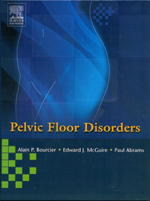I. BASIC SCIENCES
1. Gross Anatomy and Functional Anatomy of the Pelvic Floor
2. Neurophysiology of the Lower Urinary Tract
3. Physiology of Anal Continence and Defecation
4. Normal Sexual Function in Women
5. Normal Sexual Function in Men
II. PATHOPHYSIOLOGY OF THE PELVIC FLOOR DISORDERS
6. Pregnancy, Childbirth and Pelvic Floor Damage
7. Lower Urinary Tract Dysfunction in the Female:
Pathophysiology of Female Urinary Incontinence
8. Lower Urinary Tract Dysfunction in the Male
9. Urinary Incontinence in the Elderly
10. Neurogenic Voiding Dysfunction
11. Fecal Incontinence and Disorders of Defecation
12. Rectal Prolapse
13. Male and Female Sexual Dysfunction
14. Sexual Dysfunction in Female
15. Erectile Dysfunction
III. DIAGNOSIS AND EVALUATION OF PELVIC FLOOR DISORDERS
16. Office Evaluation and Physical Examination
17. Female Standard Radiologic Investigations
18 . Rectocolpocystogram (Diagnostic Methods of Evaluation)
19. Contribution of MR Imaging in the Evaluation of Pelvic Floor
Function
20. Dynamic Magnetic Resonance Imaging in the Evaluation of
Pelvic Pathology
21. Endoscopy in Benign Pelvic Floor Dysfunction
22. Urodynamic Investigations
23. Urodynamic Evaluation
24. Electrodiagnosis
25. Investigation of Disorders of Anorectal Function
26. Diagnostic Evaluation of Erectile Dysfunction
IV. CONSERVATIVE TREATMENT TECHNIQUES
27. Lifestyle Interventions
28. Pelvic Floor Muscles Exercises
29. Electrical Stimulation
30. Electrical Magnetic Stimulation Therapy
31. Biofeedback (Therapy)
32. Bladder Retraining
33. Anti-Incontinence Devices, Pads and Pants
34. Pelvic Floor Reeducation in Bowel Diseases
35. Pelvic Floor Reeducation in Uro-Gynecology
36. Management of Incontinence in the Elderly
37. Management of Men and Women Sexual Dysfunction
38. Management of Vaginismus, Vulvodyna and Childhood Sexual
Abuse
V. PHARMACOLOGY AND SURGICAL TECHNIQUES
39. Pharmacological Treatment of Urinary Incontinence
40. Surgical Treatment of Stress Urinary Incontinence in Women
41. The Tension Free Vaginal Tape Technique
42. Artificial Sphincter. Transvaginal Approach
43. Conventional and Minimized Pubovaginal Sling in Patients
With Severe Stress Urinary Incontinence
44. Surgical Treatment in Men
45. The Surgical Management of Children With Urinary and Fecal
Incontinence
46. Neuromodulation
47. Management of Neurogenic Voiding Dysfunction


